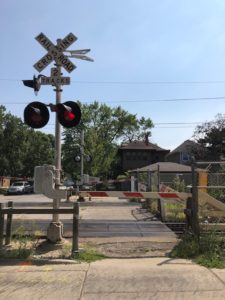 When I sit on my back deck, I often hear the rumblings of the commuter train passing by, carrying people into the city for work or back to their neighborhood on the northwest side of Chicago to enjoy their family life.
When I sit on my back deck, I often hear the rumblings of the commuter train passing by, carrying people into the city for work or back to their neighborhood on the northwest side of Chicago to enjoy their family life.
The train’s steel cars normally travel above ground or below ground, but for close to a mile, the tracks occupy the same plane as cars and bicycles, children on their way to school and dogs on leashes leading their humans to favorite trees.
Railway crossings with orange and white gates, which go up and down in jerky movements, seem to be punctuated by flashing red disks and accompanied by unrelenting clanging, warnings to stay clear of the tracks at each of the ten streets that cross their path.
When any gate starts its descent, people on either side often ask themselves whether they can cross safely before the barrier can no longer be breached.
Ah, they’re doing the safety dance.
I’ve been contemplating this a lot since COVID-19 has changed everybody’s relationship with SAFETY.
Not by intention, most of us have gotten schooled on epidemiology. We listened to daily briefings and saw related topics dominate the news. We paid attention to worldwide trends on hospital stays and applauded the service of medical professionals.
Some of us noted the names of new variants and public health policies that varied by state and municipality. Many of us got used to meeting with members of their work teams via zoom.
Even as the death toll grew, some chose not to believe that a problem existed. Store workers were threatened, a few even killed, for trying to enforce masking restrictions to prevent the spread of airborne viruses.
If the potential risk of the disease did not present enough of a safety issue, armed citizens who were more concerned with their personal freedoms than with the safety choices of their neighbors posed another challenge.
Everybody had to do a dance around this. Civil life became increasingly un-civil. So many Americans had different views on what constituted reasonable precautions that ensured everyone felt safe.
And now, the worst of COVID seems to be over, at least in America. We have vaccines and boosters. People are traveling again and filling stadiums for concerts and sporting events.
Individually, we’re still doing some sort of safety dance.
I rarely meet friends at a restaurant or ride with others in a car without trying to figure out whether to put on a mask or not.
I often choose to walk in a public place with a KN95 securely covering my mouth and nose and, upon seeing what seems to be the prevailing habit of other patrons, remove it.
When it comes to safety, I often defer to what makes people around me feel safe. I wish everybody considered the safety of others more often. How someone FEELS is the most important thing.
I try to cross streets at traffic lights or at crosswalks. I normally click on my seat belt shortly after getting behind the wheel.
Yet, there are times when I’ll run across the middle of a street or take my seat belt off when I park, before the engine is turned off. I determine whether an action constitutes a reasonable risk or not.
I determine what might make me feel “protected” as much as possible, removed from threats to my life or health.
Notions of “safety” usually imply rules and standards determined by others. People often resent anyone imposing rules of any sort.
Most of us didn’t like curfews when we were growing up. A high percentage of drivers don’t obey speed limits.
Rules can seem arbitrary or not geared to our “particular” circumstances. Owners of cars that can corner well at high speeds don’t want to go with the flow determined by the average driver and their vehicle.
I’ve met people that think owning and carrying a gun is for their protection, yet knowing that so many people carry concealed “weapons” makes me feel anything but SAFE.
When each person breaks into their own safety dance, ultimately determining their own behaviors, I hope they can remember that each person’s life is no more valuable than any other’s; that considering everyone’s safety and everyone’s feelings serves everyone.
Meantime, I’m grateful when I remember that everyone has to make up their own steps for the dance. This is an exercise in compassion.
Understanding that the difference between protection and safety is a matter of perception is no small thing.


Leave a comment